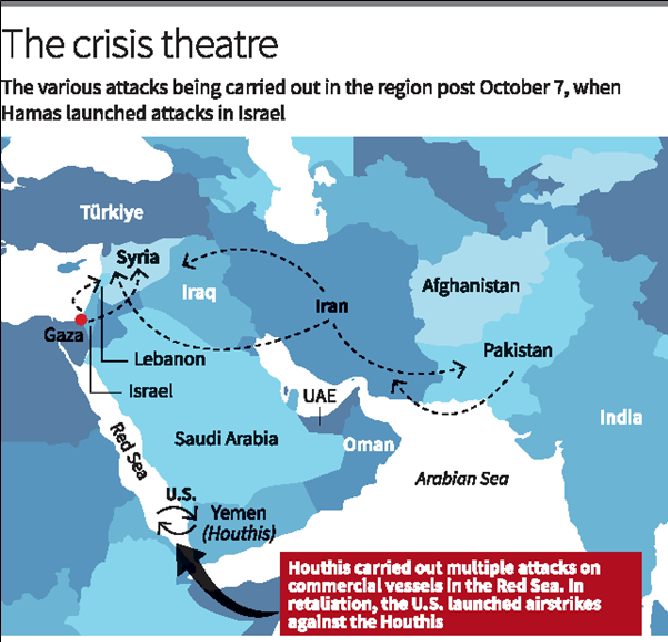Context-
West Asia finds itself plunged into a state of unprecedented turmoil as what initially appeared to be a localized conflict between Israel and Hamas has evolved into a complex and expansive regional security crisis. The situation, marked by a web of interconnected conflicts involving major players such as Israel, Iran, the United States, and various proxy groups, has far-reaching implications for the stability of the entire region.
The Genesis of the Crisis:
The conflict ignited when Israel launched a military campaign against Gaza in response to a cross-border attack by Hamas on October 7. The ongoing Israeli offensive, which has resulted in a staggering death toll of over 24,000 people within a span of 100 days, shows no signs of abating. As tensions escalated, other actors joined the fray, transforming the localized dispute into a broader regional conflagration.
The Domino Effect:
● Hezbollah, the Lebanese Shia group backed by Iran, expressed solidarity with the Palestinians by firing rockets at Israeli forces in the disputed Shebaa Farms. This act initiated a series of exchanges between Hezbollah and Israel, carefully calibrated to avoid a full-blown war. While some Arab nations pursued diplomatic channels to condemn Israel's actions, Iran-backed militias, such as the Houthi rebels in Yemen, seized the opportunity to open new fronts. In a show of solidarity with the Palestinians, the Houthis targeted commercial vessels in the Red Sea, disrupting vital shipping routes.
● The U.S. Enters the Fray: Responding to Houthi attacks in the Red Sea, the United States, a staunch supporter of Israel's actions, initiated airstrikes in Yemen, targeting Houthi positions. Simultaneously, Hashad al-Shabi, the Shia Mobilisation Forces of Iraq and Syria, supported by Iran, launched over 100 attacks against U.S. troops in both countries. In retaliation, the U.S. carried out airstrikes in Syria and eliminated a Hashad al-Shabi commander in Baghdad, leading to protests in Iraq.
● Israel's Regional Strikes: Amidst the escalating chaos, Israel conducted multiple strikes inside Syria and Lebanon, targeting not only Hamas and Hezbollah but also Iranian commanders. As instability spread, the Islamic State took advantage of the situation, launching an attack on a memorial event for Qassem Soleimani in southeastern Iran. In response to growing regional and domestic pressure, Iran carried out strikes on January 16 in Iraq's Kurdistan, Syria, and Pakistan, claiming to have targeted a Mossad operational center and Sunni Islamist militants. Pakistan retaliated with airstrikes in Iran on January 18.
Key Players in the Crisis:
While numerous actors are involved, three major operational centers have emerged: Israel, Iran, and the United States. Israel asserts its right to continue the offensive until it achieves its objectives of dismantling Hamas and securing the release of hostages. Iran, the primary supporter of anti-Israel non-state actors in the region, backs groups such as Hamas, Islamic Jihad, Hezbollah, Houthis, and Shia militias in Iraq and Syria. The United States, with a significant military presence in the region, aims to ensure the security of Israel, protect American troops and assets, and maintain the U.S.-led order in the region.
Implications for Regional Security:
● The ongoing crisis signifies a departure from the previous order in West Asia. In the past, the U.S. held a dominant presence, shaping geopolitical outcomes and maintaining stability. However, the current situation reveals a crumbling order, with Iran-backed proxies directly challenging Israeli and American positions. The Houthis' actions have disrupted one of the world's busiest shipping routes, challenging the U.S.'s ability to provide security.
● Arab countries, traditionally allies of the U.S., are increasingly frustrated with Washington's unconditional support for Israel's offensive in Gaza. Despite this support, the U.S. appears unable or unwilling to influence Israel to end the war and restore stability. The result is a region plunged into chaos, with the U.S. playing the role of a disruptor rather than a guarantor of peace, stability, and deterrence.
● Unlike past conflicts in West Asia, which often involved nation-states or state and non-state actors, the current crisis is marked by a widespread security breakdown. Notably, the 1967 war concluded within six days, but the present conflict has endured for over 100 days with no resolution. The U.S., once the architect of outcomes in the region, is now grappling with an increasingly chaotic West Asia.
● As the conflict persists, Israel's offensive in Gaza shows little sign of winding down, prompting continued attacks from Hezbollah and the Houthis. U.S. airstrikes on Houthi positions and Shia units in Iraq and Syria have not deterred further attacks. The Islamic State and other jihadist groups may exploit the spreading instability, posing additional challenges to vulnerable countries like Iraq and Syria. Iran, despite projecting force, faces limitations highlighted by Pakistan's response to Iranian strikes.
● Amidst the escalating crisis, a notable development is the holding of the Saudi-Iran detente and the associated Saudi-Houthi peace. While this represents a potential positive element amid the chaos, the overall situation remains highly precarious.
Conclusion:
West Asia is currently mired in a multifaceted crisis that transcends traditional conflict dynamics. The involvement of major powers, including Israel, Iran, and the United States, along with various proxy groups, has created an intricate web of conflicts with global ramifications. As the region grapples with instability, the path forward remains uncertain, and the potential consequences of a prolonged war extend beyond the borders of West Asia, impacting global security.
|
Probable Questions for UPSC Mains Exam-
|
- Source - The Hindu







